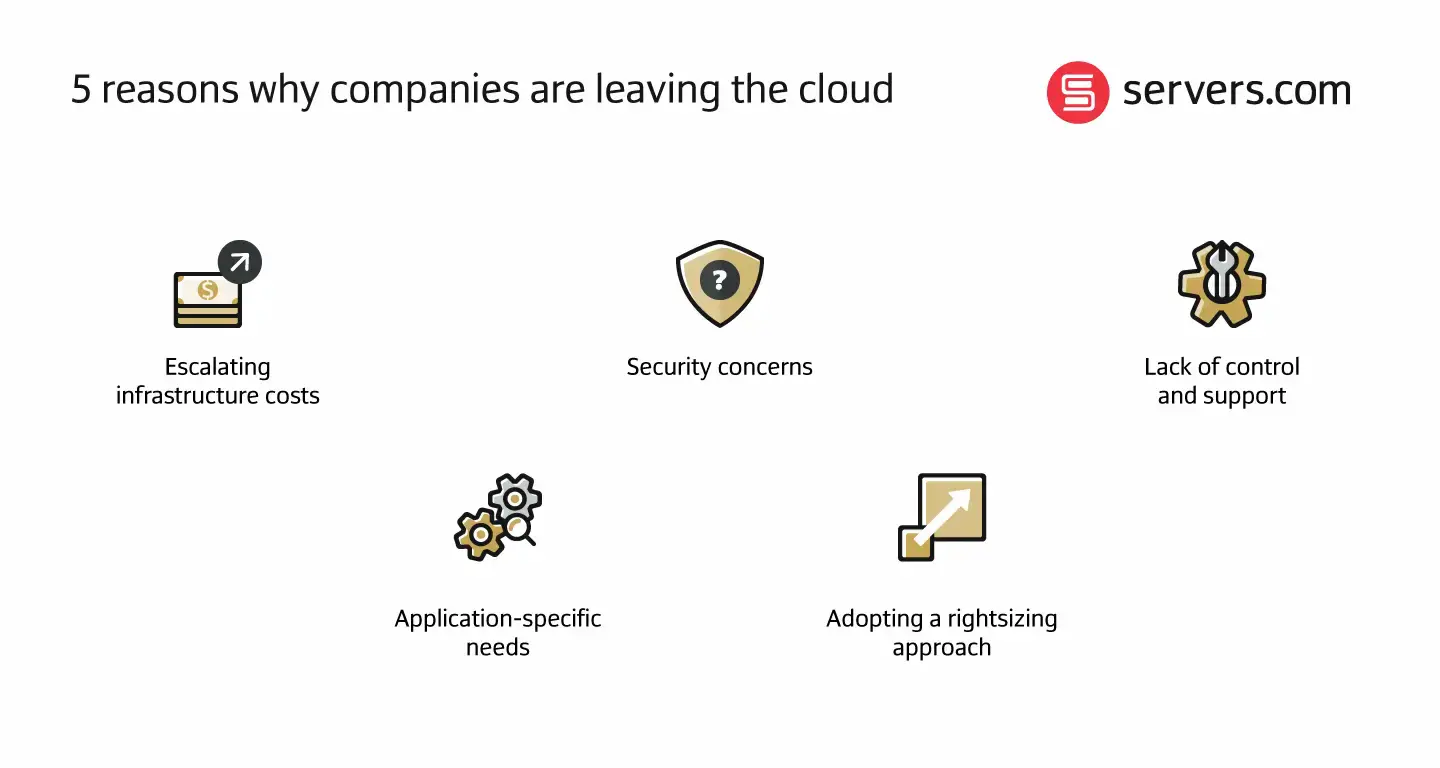

Only last year, our CRO Isaac Douglas wrote a blog post all about why the hyperscale cloud bubble is bursting. One year on and it looks like the cloud bubble has now burst.
Motivated by unmet expectations, companies are leaving cloud in favor of on-prem deployments and hybrid architectures. Rising costs, security concerns, and lack of control are just some of the challenges driving businesses away.
In this blog post we explore five reasons why companies are moving away from cloud. Starting with the problem that’s been making headlines throughout 2024– escalating costs.
Lack of transparency when it comes to infrastructure costs is one of the biggest issues faced by hyperscale cloud customers today. 42% of businesses using hyperscale cloud struggle to predict their monthly cloud bill, 28% have received an unexpectedly large bill for cloud services, and 82% end up wasting more than 10% of their overall cloud spend.
The problem typically starts when organizations sign up on free credits and design their infrastructure around specific, proprietary products. When the bills start, they’re left unable to migrate to more cost-effective solutions without completely rearchitecting or re-engineering.
By this point, it’s often too late to circumnavigate all the unexpected additional costs that start rearing their head. As Mark Grindey, CEO of Zeus Cloud, shares:
“The subscription model is just one element in a sliding scale of usage-based costs. Companies are discovering the additional fees demanded for extra security and support. They are incurring far greater storage costs, due to the tendency to charge for both storing and deleting data”.
Cloud resource usage optimization can help. But, as recent examples show, the most significant savings are to be had by either integrating alternative sources of compute or migrating away from hyperscale cloud completely.
37 Signals, for example, stand to save $7 million by 2028. The result of leaving cloud in October 2023 and purchasing $600,000 worth of Dell servers to use on-prem. Another example, Ahrefs is reported to have saved approximately $400 million over three years by renting a colocation data center in Singapore. The figure is based on the comparative cost of 850 identical servers in colocation versus AWS.
Now, off the back of these high-profile cloud-exit cases, the conversation around cloud costs has well and truly taken off online. X posts like this one by IT consultant Shawn Dedalus are becoming increasingly commonplace.
IT leaders are starting to question long-held assumptions about cloud, leading more businesses to consider their own infrastructure choices.
Hyperscale environments are prime targets for security challenges. 61% of organizations have already experienced a cloud security incident in 2024, 21% of which resulted in a data breach.
In January, a major user data leak in Microsoft Azure left hundreds of executive accounts compromised and up to 97,000 Microsoft Exchange servers susceptible to attack. It follows a similar breach in 2023 and a wider escalation in security breaches amongst tech giants.
Because hyperscale cloud providers run on a model of shared responsibility, there’s always the risk that another business residing on your server will make a security-compromising mistake. And because most data breaches result from human error not hardware failure the risk is always present - sharing hardware leaves you vulnerable to the mistakes of others.
Improperly configured S3 buckets in AWS cloud servers, for example, are one of the biggest causes of data breaches. S3 buckets provide object-based storage. When misconfigured, they become vulnerable to attackers who can upload malicious files, remove files, and compromise file integrity.
It’s no wonder then that 33% of organizations cite security issues as motivation for leaving public cloud. Many organizations (particularly those dealing with sensitive data) feel more secure managing their own infrastructure, data and security protocols.
One of the biggest misconceptions around cloud is that cloud providers offer really great support. In reality, help is negligible unless you’re willing to pay an additional premium on top of your base subscription rate. Break-fix-only support is standard, you’re not going to get personalized solutions (most likely just a link to a knowledge base article), and it can take weeks if not months to get a response after raising a ticket.
“You rarely get proper attention for things that matter to your business but are not critical for your cloud provider,” shared the global director of technology of an iGaming platform.
Having limited control over your technology and no guarantee of timely support when things go wrong can have serious ramifications. Especially for organizations that can’t afford downtime. Whilst going on-prem doesn’t fix the support issue, provided you’ve got a specialized team, it does mean you’ll have complete control over managing and troubleshooting your technology. So, you won’t be at the mercy of a ticketing system.
And for organizations that do want the support of a hosting provider, there are hyperscale cloud alternatives out there that offer tailored and reliable support. More specialized bare metal server hosting, for instance, will work with you to fix issues as they arise in real-time, with the support of real, human experts.

Cloud marketing over the past decade has pushed the idea that public hyperscale cloud solutions are a fix-all to every type of workload. But this simply isn’t the case. Not all applications are best suited to the cloud. Hyperscale cloud products have been designed for modern applications and many enterprise workloads that currently sit in the cloud should probably never have been put there in the first place.
Back when cloud adoption was at its height, enterprises moved their legacy applications to the cloud en masse. But these legacy applications weren’t set up to make use of cloud features like containerization, Kubernetes, or serverless.
These incompatibilities resulted in inefficiencies, increased costs, and reduced performance over time. So, unless an organization plans to completely refactor their applications for the cloud, they’re almost certainly better off being run on dedicated servers.
Businesses are starting to realize there are greater freedoms to be had by avoiding overinvesting in a single technology. As a result, we’re seeing an increasingly nuanced approach to infrastructure being taken, with hybrid deployments becoming commonplace.
“Any organization of size, dealing with diverse technology, is doing their company a disservice if a public cloud-only strategy is their end goal,” said Brian Shields, SVP and CTO of Boston Red Sox and Fenway Sports Management. Like an increasing number of businesses with complex workloads, Shields’ teams are adopting hybrid models, maintaining some compute and storage in hyperscale cloud, whilst also utilizing on-premises and colocation deployments.
Jeremy Roberts, Research Director at Info-Tech agrees: “[Public cloud is] not a cure-all, and it does take a bit of effort to systemize your approach and make consistent, defensible decisions about your cloud services”.
For most businesses, making infrastructure choices on a workload-specific basis will enable them to optimize performance, cost, and increase redundancy by avoiding that single point of failure. It means they can keep that hyperscale scalability where it’s needed and combine it with some on-prem, bare metal cloud or colocation where it fits.
Off the back of high-profile cloud exit success stories, more companies are feeling emboldened to execute their own cloud exit strategies.
It’s not because cloud doesn’t serve a purpose anymore (in the age of AI public cloud is more relevant than ever). It’s because the way we were pushed to use cloud services has proven to be inefficient at best, ineffective at worst.
Today, companies are leaving cloud and adopting a new, nuanced approach to infrastructure. For some that means moving their technology back on-prem or into colocation. But for most it means adopting a hybrid approach combining the best compute types for each workload.

Frances is proficient in taking complex information and turning it into engaging, digestible content that readers can enjoy. Whether it's a detailed report or a point-of-view piece, she loves using language to inform, entertain and provide value to readers.